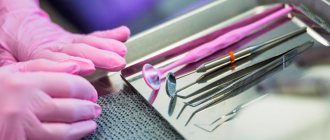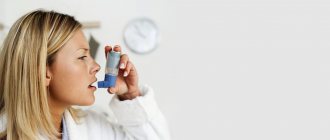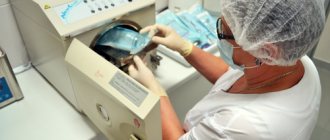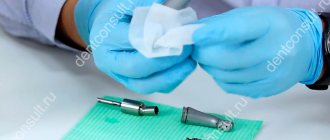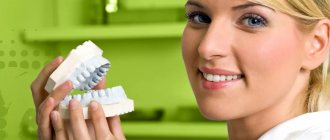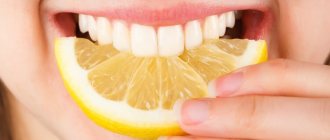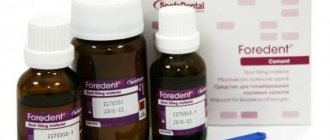Sterility for materials and instruments
Most dental supplies are disposable and supplied in individual sealed packages. These are masks, gloves, napkins, brushes and applicators for applying varnishes and gels, tablets on which pastes are mixed, elements of saliva ejectors, etc.
Reusable instruments and materials undergo special treatment after each patient. It is performed in several stages:
- disinfection - soaking in solution for 2 hours;
- mechanical cleaning;
- washing (ultrasound can be used to remove all contaminants);
- washing in distilled water;
- drying;
- packaging in disposable sealed bags;
- dry heat or steam treatment (at high temperature).
After the sterilizer, the instrument remains in individual packaging, which is opened only before use in the presence of the patient.
Sanitary standards allow the use of conventional autoclaves in dental offices. In such equipment, superheated steam is supplied under pressure to sterilize accessories. The method is effective, but it does not always completely clean the pores on the surface of the instruments (if any). To increase the reliability of processing, dry heat sterilization is used, the temperature at which is so high that all microorganisms die. Another option is the use of automated autoclaves, with control of the operating protocol. To check the quality of cleaning, chemical indicators are additionally used - azopyram samples. If traces of biological material remain on surfaces, they show this. The results of such checks are recorded in a separate journal.
After sterilization and until use, reusable instruments are stored in special boxes with bactericidal irradiators. However, they are not removed from sealed bags.
Sterilization of dental instruments
Today, almost every person who crosses the threshold of a dental institution knows that everything the dentist touches must be as clean as possible, treated according to all the rules from microorganisms, so the presence of modern sterilization equipment in the clinic has become a guarantee of peace of mind for the patient and, as a result, a fact , increasing the prestige of this clinic. Thus, when choosing a dental institution, it is recommended to pay attention, first of all, to the degree of its equipment for sterilization and disinfection of medical instruments, and only secondly to the merits of the staff and the price of the services provided.
In every dental office, regardless of its functional focus, instruments and materials must be stored in sterile conditions. Usually this is a sterile table set according to all the rules or sets of sterile instruments sealed in bags. Ideally, treated instruments should be stored in sterile, disposable packaging and opened only in the presence of the patient. The presence of sterilely packaged tips and instruments in a dental clinic tells the patient about the level of responsibility of this medical institution and the preservation of his health.
Any dental office must be equipped with a bactericidal ultraviolet irradiator, which is used to carry out quartz treatment. You should also disinfect surfaces in your dental office, including equipment, faucets, and door handles.
Anti-infective protection of a doctor and his assistant during patient visits is largely determined by the correct use of disposable and reusable clothing, caps, gloves, safety glasses, and hand hygiene products that have bactericidal and antiviral effects. Despite the fact that medical personnel always work in disposable sterile gloves, careful hand cleaning is necessary, since a huge number of microorganisms accumulate on them.
So, all instruments intended for medical purposes must be subjected to sterilization, a complex process of destroying all types of microbial flora and viruses using physical or chemical agents. Sterilization can be steam, dry heat and gas. Currently, steam sterilization (in autoclaves) is the preferred method of eliminating the risk of cross-infection from contaminated equipment, recommended by the World Health Organization and the Center for Disease Control for healthcare workers.
For reliable sterilization of dental instruments, advanced clinics use class “B” autoclaves, which allow sterilization of any medical instruments, linen, dressings and where all phases are controlled automatically, there is an interface with a printer and a personal computer for logging the entire process. Moreover, when sterilizing dental handpieces that have a complex structure of internal channels, only class “B” autoclaves are allowed.
Class “B” autoclaves can sterilize all types of medical instruments and materials: solid, hollow, porous, individually or double-packed of any type. They are equipped with a pre-vacuum cycle and vacuum drying at the end of the sterilization process, which reliably eliminates all infections and does not damage the surface of autoclavable instruments.
You can find out about the sterilization equipment of ProfiSmile dentistry here
Treatment of dental offices
Cleaning regulations are determined by sanitary standards. All surfaces must be smooth, easy to clean, without microscopic pores or roughness. They are treated with disinfectants several times a day. Disinfection is carried out for furniture and equipment of walls, floors, ceilings, window sills, etc.
Dental offices must be equipped with special medical furniture. It is made from materials with surfaces that can withstand repeated disinfection and are free of micropores.
After each appointment, additional processing of all items touched by the doctor or patient is performed.
Some infections are transmitted by airborne droplets. To protect against them, dentistry can use bactericidal recirculating lamps (they continuously disinfect the air; they can operate in the presence of the patient), closed-cycle UV emitters, and special filters. A separate ventilation system is installed for surgical rooms. The air passes through fine filters. Access to the room must be through the sterilization department.
Dental equipment
Water supply systems. They are used to cool the tooth tissue during preparation. The jet is supplied through the tip. This treatment can only be carried out with distilled water. The design of the units is such that liquid from the oral cavity cannot enter the line even with a constant change in pressure.
Tips. During treatment, they come into contact with tooth tissue and require especially thorough cleaning. It becomes more complicated because the tips may have hidden cavities in which bacteria accumulate. For high-quality cleaning, the tip is blown twice: to remove mechanical impurities and rinse it with a hot antiseptic solution. Only after this is it sterilized in a disposable sealed bag.
Other tools. Endodontic accessories, burs, and scaler tips are stored in closed containers after treatment. You can only remove them from there with disposable sterile tweezers.
Individual dental kits. They include masks, gloves, aprons, and caps for the doctor and assistant. Special bags are used for waste materials. The standard set includes tips for a vacuum cleaner and a saliva ejector. If anesthesia is performed, the carpule and needle are disposable.
The described sterilization and disinfection protocol is used at the DentoSpas clinic and complies with the AntiAIDS and AntiHepatitis program. It ensures the safety of the patient during a dental appointment and eliminates infection and infection.
Cleaning, disinfection, lubrication, sterilization of dental handpieces
1. Preparation Disconnect the turbine handpiece from the adapter and remove the bur from the collet. Move turbines to a designated area with a clean environment. Remove organic contaminants with a paper towel.
2. Cleaning Manual: Clean the outer surface of the turbine with running water (<38˚C, demineralized water is recommended). Automatic: NSK turbine handpieces with this symbol on the body can be cleaned and sterilized in a thermal disinfector. When using the thermal disinfection device, follow the manufacturer's instructions.
NSK recommends using the Care3 Plus for automatic tip cleaning and lubrication. The device is easy to use and provides thorough lubrication regardless of operator skill and experience.
Easy to use:
| Open the door and carefully secure the lugs to the connectors (Up to 3 tips at a time). |
| Close the door tightly. Care3 Plus will not start if the door is not closed securely. |
| Select a cycle (Short, Long or Extra Long) for each tip. |
| Press the START button. Wait about two minutes for Care3 Plus to finish cleaning and lubricating. |
3. Disinfection Manual: Thoroughly wipe the outer surface of the turbine with a cleaning or disinfectant solution.
4. Lubrication It is recommended to lubricate the turbine tips twice a day - at the beginning and at the end of the day. If you continuously use the turbine for more than half an hour, lubrication is strongly recommended. Use an oil absorber to avoid airborne oil dust.
● Mandatory before sterilization ● Mandatory after each thermal disinfection
Manual: Lubricate the turbine with Pana Spray Plus / Pana Spray from NSK. To prevent oil from entering the environment, use an absorbent wipe. Remove excess grease.
Automatic: clean and lubricate turbines with Care3 Plus from NSK. Choose the right adapter for each turbine.
| A) Disconnect the turbine housing from the adapter. B) Insert the Phatelus Connector Spray nozzle into the tip and turn clockwise approximately 10 times. ● To prevent oil leakage, make sure the spray nozzle is securely seated in the tip. ● Use the PA spray nozzle to lubricate Pana Air series turbines. |
| C) Insert the nozzle into the rear of the turbine housing (connector side) and begin spraying. ● Make sure oil is coming out of the front of the head. ● If dirty oil comes out of the head, repeat spraying until clean oil comes out. ● The collet needs to be serviced. The recommended interval is once a week. |
5. Sterilization in an autoclave, class “B”. Now there are many manufacturers of medical autoclaves on the market, but there are only three special models for handpieces - the main one is Melaquick 12 +
If you have a regular autoclave in your clinic (and not a special one for handpieces), place the turbine tips in a sterilization bag and seal it. EN13060 4.6.3 recommends sterilization in an autoclave for 3 minutes (minimum holding time) at 134˚C or 15 minutes (minimum holding time) at 121˚C. NSK recommends Class B or S sterilization. All NSK turbines can be sterilized in an autoclave at temperatures up to 135˚C.
6. Storing handpieces after cleaning and lubrication: Immediately after the sterilization cycle, remove the turbine handpiece from the autoclave. Store the handpiece in a sterile, dust-free container or bring it to the treatment room for use.
